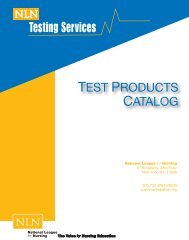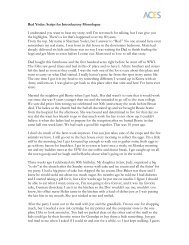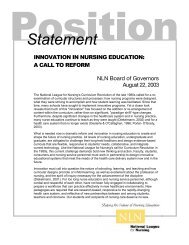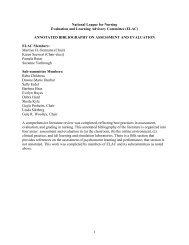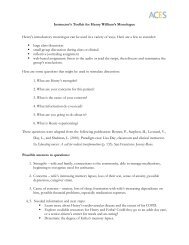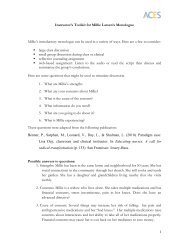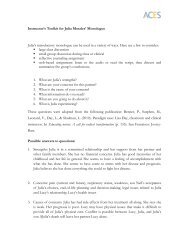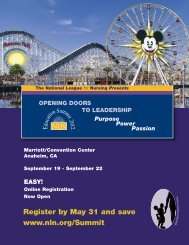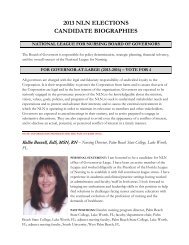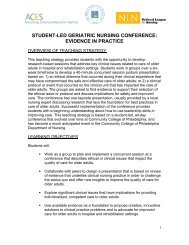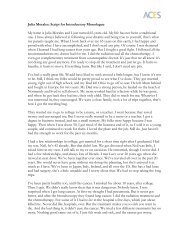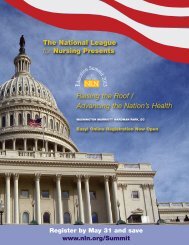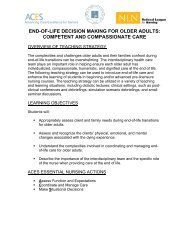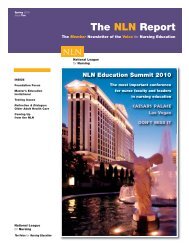Using Continuing Care Retirement Communities to Enhance a ...
Using Continuing Care Retirement Communities to Enhance a ...
Using Continuing Care Retirement Communities to Enhance a ...
Create successful ePaper yourself
Turn your PDF publications into a flip-book with our unique Google optimized e-Paper software.
Advancing <strong>Care</strong> Excellence for Seniors<br />
<strong>Using</strong> <strong>Continuing</strong> <strong>Care</strong> <strong>Retirement</strong> <strong>Communities</strong> <strong>to</strong><br />
<strong>Enhance</strong> a Better Understanding of Older Adults<br />
OVERVIEW OF TEACHING STRATEGY<br />
<strong>Continuing</strong> <strong>Care</strong> <strong>Retirement</strong> <strong>Communities</strong> (CCRC) provide varying levels of support <strong>to</strong><br />
older adults. Generally these communities have older adults living in independent<br />
situations, in assisted living situations, in skilled long term care, in dementia care units,<br />
and at times in short term rehabilitation units. The level of nursing interventions varies<br />
within each of these levels of care. These CCRCs provide valuable teaching and learning<br />
opportunities for pre-licensure nursing students that enhance their understanding of older<br />
adults. For example, exposing students <strong>to</strong> older adults living independently often changes<br />
their attitudes that older adults are vulnerable and non-productive. Further, older adults in<br />
assisted living often require a different level of care secondary <strong>to</strong> either their cognitive or<br />
physical changes. Being able <strong>to</strong> care for the most vulnerable of older adults in the skilled<br />
nursing units or dementia units, with better understanding of who they may have been<br />
prior <strong>to</strong> needing that level of care, provides an experience for students <strong>to</strong> develop the<br />
empathy, skills, and abilities <strong>to</strong> provide that type of care. Understanding the different<br />
levels of care and experiences of transitioning older adults, whether the transition is<br />
permanent (independent living <strong>to</strong> assisted living) or temporary (rehabilitation <strong>to</strong><br />
independent living) is vital <strong>to</strong> providing optimal care <strong>to</strong> this population. Helping students<br />
develop a better understanding of how <strong>to</strong> address older adults’ needs, while considering<br />
the risks and benefits of maximizing older adults’ quality of life are key lessons that can<br />
be learned in CCRC. This teaching strategy provides activities <strong>to</strong> help students better<br />
understand the complexity of care of older adults as a way <strong>to</strong> develop a sense of empathy<br />
and value for this population.<br />
LEARNING OBJECTIVES<br />
The student will:<br />
• Develop a better understanding of issues related <strong>to</strong> transitioning among care<br />
settings with regard <strong>to</strong> older adults<br />
• Utilize <strong>to</strong>ols <strong>to</strong> assess physiological and psychosocial needs of older adults<br />
• Recognize and respect the values of older adults<br />
• Understand the complexity of care of older adults<br />
• Recognize the need <strong>to</strong> assess functioning when the older adult is transitioning<br />
among care settings
Advancing <strong>Care</strong> Excellence for Seniors<br />
ESSENTIAL KNOWLEDGE DOMAINS<br />
• Individualized Aging<br />
• Complexity of <strong>Care</strong><br />
• Vulnerability During Transitions<br />
ACES ESSENTIAL NURSING ACTIONS<br />
• Assess Function and Expectations<br />
• Coordination and Management of <strong>Care</strong><br />
• Use Evolving Knowledge<br />
• Make Situational Decisions<br />
NLN EDUCATION COMPETENCIES<br />
• Human Flourishing<br />
• Spirit of Inquiry<br />
GETTING STARTED<br />
This teaching strategy focuses on assessing function and expectations of older adults as<br />
well as the coordination and management of care. It also enhances the student’s spirit of<br />
inquiry and nursing judgment.<br />
A. Show the PowerPoint presentation introducing students <strong>to</strong> the ACES Essential<br />
Actions as a way <strong>to</strong> organize their thinking about assessing and addressing the<br />
needs of older adults.<br />
B. The activities in this teaching strategy can be used in a geron<strong>to</strong>logy rotation or<br />
in a community rotation and can be used over a period of four clinical days or<br />
the entire rotation.<br />
C. Have students take this quiz on Myths of Aging<br />
and discuss their answers.<br />
D. Have students interview an older adult living independently. Prior <strong>to</strong> the<br />
interview, have them consider the following:<br />
1. What parameters would you consider when assessing the ability of an<br />
older adult <strong>to</strong> live alone<br />
2. Think about an older adult in your family or community who lives<br />
independently. Discuss their quality of life, resources that assist in their<br />
independence, safety issues and general perceptions of older adults.<br />
3. During the interview, first consider the concepts of therapeutic<br />
communication when discussing the client’s family, expectations in life,
Advancing <strong>Care</strong> Excellence for Seniors<br />
work his<strong>to</strong>ry, frustrations, accomplishments and hobbies. Engage in<br />
discussion about what it was like <strong>to</strong> move <strong>to</strong> their current apartment,<br />
experiences going from the hospital <strong>to</strong> home or rehabilitation and possible<br />
feelings about independence and dependence on others, such as living in a<br />
nursing home.<br />
4. Obtain a health his<strong>to</strong>ry, but this should not be the main focus of the<br />
interview. This health his<strong>to</strong>ry should include a list of medications. Select<br />
the appropriate <strong>to</strong>ol(s) from the how <strong>to</strong> try this series <strong>to</strong> further evaluate<br />
the client. An example of appropriate <strong>to</strong>ols based on the interview :<br />
• Geriatric Depression Scale<br />
• Katz Index of Independence<br />
• Law<strong>to</strong>n Daily Living Scale<br />
• Modified <strong>Care</strong>giver Strain Index<br />
• Short Michigan Alcohol Screening Instrument<br />
• Brief Evaluation of Executive Dysfunction<br />
• Beers Criteria<br />
• Mini Cog<br />
• The Pittsburgh Sleep Quality Index<br />
E. Have the student repeat the interview with a client living in assisted living and<br />
then again with a client living in a skilled long term care unit or dementia unit.<br />
Look at the list of <strong>to</strong>ols from the how <strong>to</strong> try this series and select appropriate assessment <strong>to</strong>ols.<br />
The <strong>to</strong>ols listed above may be appropriate or also consider:<br />
• SPICES<br />
• The Hendrich II Fall Risk Model<br />
• Delirium<br />
• Preventing Aspiration in Older Adults with Dysphagia<br />
• Avoiding Restrains<br />
• Communication Difficulties<br />
F. If the facility also has a rehabilitation unit, have the student interview a client<br />
on that unit. These are clients likely <strong>to</strong> have come from a hospital setting and<br />
are returning <strong>to</strong> their previous home environment. These clients have<br />
experienced multiple transitions and the students can explore the multiple<br />
issues around these transitions. Again consider the client’s expectations,<br />
frustrations, willingness <strong>to</strong> consider risks and benefits of choices, and<br />
functional status. Have the student consider the following mini case study and<br />
encourage them <strong>to</strong> think about these points when they conduct their interview.<br />
I’m Anna and I know I am 88 years old and people think I should be<br />
someplace…in a home or assisted living or around other people, but I really<br />
love my condominium. I like living alone with my cats. Yes, I remember that I<br />
did fall and couldn’t get <strong>to</strong> the phone. I was on the floor for almost 24 hours
Advancing <strong>Care</strong> Excellence for Seniors<br />
when my son found me. They rushed me <strong>to</strong> the hospital fixed my broken hip<br />
and then I came <strong>to</strong> this rehabilitation unit <strong>to</strong> get stronger. I don’t really like<br />
the place. They tell me what <strong>to</strong> do all the time, call me “honey” and I can<br />
never get a straight answer from anybody about when I can go home. I<br />
thought I was doing well; I was walking…a bit slowly but still walking. Now<br />
my family wants me <strong>to</strong> move in<strong>to</strong> an assisted living unit or have somebody live<br />
with me. I don’t want that….I want <strong>to</strong> go back <strong>to</strong> my condominium and<br />
continue <strong>to</strong> live my life.<br />
• Can Anna go home<br />
• What are the considerations if she does go home<br />
• Do risks outweigh benefits<br />
• Is safety the ultimate fac<strong>to</strong>r in this case<br />
• How do you think Anna’s quality of life would be if she moved from<br />
her condominium<br />
• How much of a concern is her quality of life<br />
• Who makes the decision on safety regarding Anna<br />
• Anna went from home <strong>to</strong> a hospital <strong>to</strong> a rehabilitation unit and then<br />
will be transitioned <strong>to</strong> another setting. What are the issues with such<br />
transitions<br />
G. Have the students again consider what <strong>to</strong>ols would be appropriate <strong>to</strong> continue<br />
<strong>to</strong> evaluate this client. Again utilize the <strong>to</strong>ols from the how <strong>to</strong> try this series.<br />
Consider such issues as depression, cognitive changes and functionality as a<br />
client is transitioning from a hospital <strong>to</strong> rehabilitation unit <strong>to</strong> home or <strong>to</strong><br />
assisted living.<br />
The final assignment is <strong>to</strong> have the students reflect on and discuss their experience.<br />
Students should keep a journal of their experiences with each of the clients they<br />
interviewed. The journals should include both objective and subjective data as well as the<br />
student’s feelings on quality of life, frustrations and thoughts about their perceptions of<br />
older adults before and after the assignment. They should consider any differences in<br />
perceived functionality, expectations and quality of life between the different levels of<br />
care.<br />
.<br />
They should consider the elements of the essential actions of ACES.<br />
• Assess Function and Expectations<br />
• Coordination and Management of <strong>Care</strong><br />
• Use Evolving Knowledge<br />
• Make Situational Decisions
Advancing <strong>Care</strong> Excellence for Seniors<br />
H. Students could discuss their reflections with the group. The group could<br />
compare how decisions are made regarding the older adults they interviewed<br />
and/or cared for in a CCRC: who makes these decisions, how functionality<br />
impacts where an older adult lives, what fac<strong>to</strong>rs impact an individual’s quality<br />
of life and are risks and benefits considered when thinking about quality of<br />
life. Students can discuss also the importance of: advocating for older adults,<br />
considering the older adult’s expectations and what risks they are willing <strong>to</strong><br />
take <strong>to</strong> live the best quality of life possible, and how <strong>to</strong> coordinate and manage<br />
care in caring for the older adults.<br />
I. While this assignment can be done in two clinical days, the impact would be<br />
more significant if students could spend a longer period of time with each<br />
older adult <strong>to</strong> better develop an understanding and empathy for their needs.<br />
MATERIALS<br />
Access <strong>to</strong> a retirement community with varying levels of care.<br />
SUGGESTED READINGS AND RESOURCES<br />
These are three articles from The New York Times, written for the lay person, and<br />
provide a different perspective for the nursing student. The articles look at real<br />
issues faced by older adults and may ignite interesting conversation for the<br />
students.<br />
• http://www.nytimes.com/2012/05/10/business/retirementspecial/talkingpast-older-people-<strong>to</strong>-their-younger-companions.html_r=1&ref=elderly<br />
• http://newoldage.blogs.nytimes.com/2012/04/19/elderly-nomore/ref=elderly<br />
• http://lens.blogs.nytimes.com/2012/04/04/his-neighbors-keeper-andchronicler/ref=elderly<br />
• http://www.nytimes.com/2010/07/29/garden/29parents.htmlpagewanted<br />
=all<br />
• blog: http://www.geripal.org/2012/03/elders-older-adults-seniorslanguage.html
Advancing <strong>Care</strong> Excellence for Seniors<br />
ASSESSMENT TOOLS<br />
Utilize the resources on Consult Geri RN<br />
for the how <strong>to</strong> try this series <strong>to</strong>ols. The students can watch a video, print out<br />
the <strong>to</strong>ol or read an article directly related <strong>to</strong> the <strong>to</strong>ol utilized. There are 30<br />
<strong>to</strong>ols that may be appropriate <strong>to</strong> use for the wide range of clients and families<br />
that the students will meet. They can choose what <strong>to</strong>ols would be most<br />
appropriate for the clients they interview. A full list of the <strong>to</strong>ols follows:<br />
• Fulmer SPICES<br />
• The Geriatric Depression Scale<br />
• The Braden Scale<br />
• Predicting Pressure Ulcer Risk<br />
• The Hendrich II Fall Risk Model<br />
• Mini Cog<br />
• Predicting Patient Falls<br />
• Recognition of Dementia in Hospitalized Older Adults<br />
• Detecting Delirium<br />
• Preventing Aspiration Older Adults with Dysphagia<br />
• Assessing Nutrition in Older Adults<br />
• Avoiding Restraints in Patients with Dementia<br />
• Communication Difficulties<br />
• Communication Difficulties in Hospitalized Older Adults with<br />
Dementia<br />
• Katz Index of Independence<br />
• Moni<strong>to</strong>ring Functional Status of Hospitalized Older Adults<br />
• The Law<strong>to</strong>n Daily Living Scale<br />
• The Pittsburgh Sleep Quality Index<br />
• Pain Assessment in People with Dementia<br />
• Evaluating Sleep Quality in Older Adults<br />
• Pain Assessment in Older Adults<br />
• Assessment of Sexual Health in Older Adults<br />
• <strong>Using</strong> Pain-Rating Scales with Older Adults<br />
• Eating and Feeding Issues in Older Adults with Dementia<br />
• The Hospital Admission Risk Profile (HARP)<br />
• The Hospital Admission Risk Profile<br />
• The Family Preferences Index<br />
• The Modified <strong>Care</strong>giver Strain Index<br />
• Horowitz Impact of Event Scale<br />
• The Short Michigan Alcohol Screening Instrument – Geriatric<br />
Version (SMAST-G)<br />
• Brief Evaluation of Executive Dysfunction<br />
• Elder Mistreatment Assessment<br />
• Assessment of Transient Urinary Incontinence in Older Adults
Advancing <strong>Care</strong> Excellence for Seniors<br />
AUTHOR INFORMATION<br />
Laureen Tavolaro-Ryley, RN, MSN, CS<br />
Associate Professor of Nursing<br />
Community College of Philadelphia<br />
Philadelphia, PA.<br />
lryley@ccp.edu



